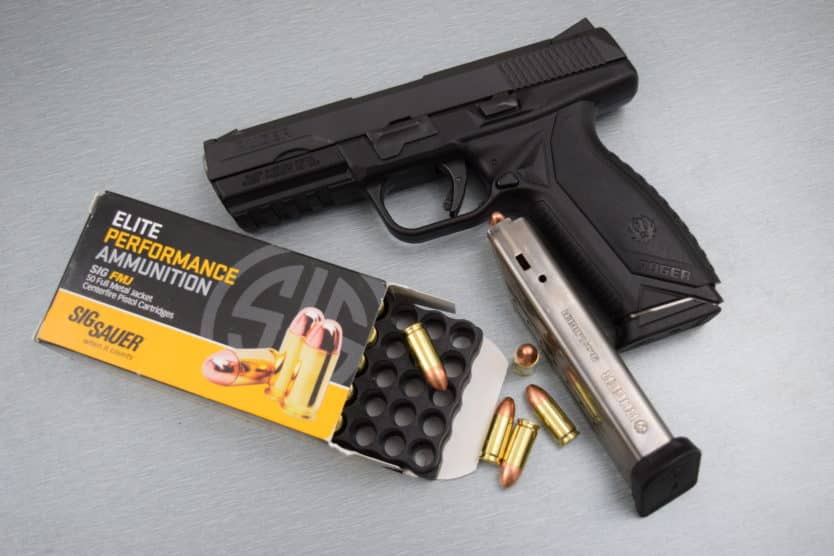Due to their snag-proof lack of protruding hammer, striker-fired pistol designs have flooded the concealed carry market. Manufacturers such as Glock, Smith & Wesson, Springfield Armory all have popular models of striker-fired pistols. But, how does striker fire actually work?
What Is A Striker-Fired Pistol?
A striker-fired pistol is a type of pistol where a spring-loaded striker directly hits the cartridge primer and fires the gun instead of relying on a hammer hitting the firing pin.
They first came into being back in 1878, in the form of a ‘hammerless automatic shotgun’ invented by legendary American gunmaker, Daniel LeFever. The system is now found in several modern semi-automatic pistols, bolt-action rifles, and shotguns.
How Does A Striker-Fired Pistol Work?
The mechanism of a striker pistol is slightly similar to that of a launcher in a pinball machine.
For a bullet to propel from its cartridge, the gunpowder inside the casing should be ignited. Rimfire and centerfire rounds involve two different means of accomplishing this but both contain primers on the backside of the casing.
In centerfire rounds, the primer is present only in the center of the back cartridge while in the case of rimfire rounds, the primer covers the whole base of the casing. With either kind of ammunition, the backside of the casing should be struck with sufficient force to kindle the primer. This catalyzes the gunpowder explosion which finally pushes the bullet from the cartridge through the barrel of the gun.
In striker-fired pistols, the striker hits the casing and ignites the primer within. When you pull the trigger, the trigger bar gets released. The striker is now pushed forward as the power that was compressed in the spring relaxes.
This rectilinear motion propels the striker forward and impacts the cartridge primer which consequently fires the round.
Firing Pin In Striker Fired Pistols
In a few designs, the striker moves forward and impacts with a firing pin (like a hammer strike), and in few other designs, the firing pin and the striker are a singular unit.
The 2 important components in a striker fired pistol are simply the striker(left) and the sear(right). Of course, there are other parts in the pistol, but for this topic, this is all we need to concern ourselves with since these are the two things that make a striker-fired pistol what it is. The below pictures are from the Steyr M9, one of my favorite striker-fired pistols.
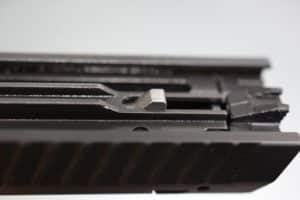
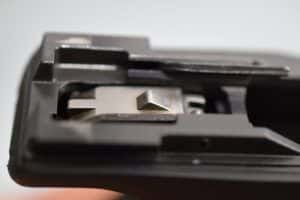
The nose of the striker being what you see protruding above on the left, is what catches on the sear to the right. The spring pulling or pushing the striker towards the primer is strong, making sure to give a good strike to the primer. The springs are made strong like this to ensure a long and reliable service life as well.
Single Action Vs Double Action
What Does Single Action Mean?
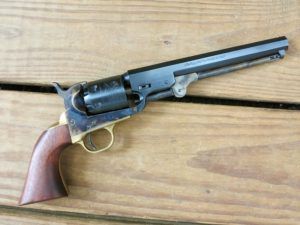
Single action (SA) means that the trigger does only one action – discharging the hammer to fire the gun. If you just press the trigger without cocking the hammer manually, you won’t see anything happen.
Since launching the hammer is the only action involved, single-action trigger pulls are generally crisp, smooth, and lightweight.
The big downside here is that the cylinder that holds the bullets is fixed and hence you can’t remove all the cartridges at once. You will need to load and eject them one by one.
What Does Double Action Mean?
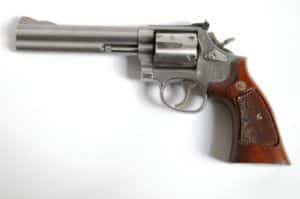
Double action (DA) means that the trigger does two actions – cocking and releasing. In double-action pistols, the trigger pull is heavier and longer and each consequent pull will be identical.
The best thing about double-action pistols with an exposed hammer is that they can be converted into single-action by cocking the hammer manually before pushing the trigger.
The flip-out chamber of double-action pistols allows for faster reload speed.
These are considered to be safer than a single-action or striker-fired pistol since the heavier and longer trigger pull reduces the chances of accidental firing. This makes it the best choice for beginners who are not as confident as experienced shooters. Though complacency can’t be encouraged in firearms, it does promote more peace of mind.
Double-Action/Single-Action (Da/Sa) Handguns
This has a mix of both types of trigger pulls to give the best of both worlds.
In this, after the initial trigger pull, the trigger is cocked and the first shot fires out after releasing the firing mechanism- be it striker or hammer. Each shot fired thereafter is single-action as the slide after the first shot cycles back and cocks the firing mechanism. This mechanism continues with every consequent shot.
Usually, handguns with this kind of trigger are armed with a de-cocking lever which discharges the firing mechanism from cocked to un-cocked state safely. Single-action/ double-action lets you manually cock the hammer or press the trigger to cock the hammer and release it to fire.
What about a striker-fired pistol? Many argue that striker fired-guns can’t be classified as single or double-action since they are hybrid. Let’s now have a look at various aspects of a striker-fired pistol.
-> Best .357 Revolvers Reviewed
What is the difference between striker fired and hammer fired?
When we say hammer-fired pistols, it most likely conjures up a picture of Hollywood cowboys cocking their pistol’s hammer all the way back to its firing position. At least in a cultural context, striker-fired pistols are less popular because their hammerless striker is hidden inside the gun.
The pros and cons of the two firing techniques have been the subject of an ongoing debate with fans of each offering several emotional reasons to substantiate their claims.
But which one is better really? Before we answer that question, let’s look at some primary differences between the two firearm designs.
Striker Fired Vs. Hammer Fired Pistols
The primary difference between a striker-fired and a hammer-fired gun lies in the way the firing pin is activated. It is different from a hammer-fired gun in that it does not depend on a hammer to hit the firing pin and ignite the cartridge primer.
In a striker-fired pistol, an internal, spring-loaded striker cocks back and fires the cartridge when you pull the trigger, instead of a physical hammer.
There’s a wealth of information out there on the pros and cons of hammer-fired and striker-fired guns. Ultimately, it’s your preference that matters when making a purchase decision.
Recognizing the need for some clarity, we’ll give you a rundown on the various aspects of hammer-fired and striker-fired guns, information on how a striker-fired pistol works, and what a striker-fired pistol is.
Armed with this knowledge, you can decide for yourself which one is right for you
In some hammer-fired guns, the hammers are contained internally and hidden from outward appearance but their workings are the same.
When you pull the trigger to release the trigger sear, the hammer bounds forward, directly or indirectly, and strikes the firing pin. The striking pin in turn hits the cartridge primer, firing the pistol.
In the older pistol designs, the hammers are exposed and the firing pin is directly attached to the hammer. In modern designs, the hammers contain a flat face that strikes a firing pin, which in turn hits the primer and fires the cartridge.
The striker-fired pistol varies from a hammer-fired pistol in that it’s not dependent on a hammer striking a firing pin to kindle the cartridge primer.
Rather, it uses a spring-loaded firing pin that is partly cocked by the slide movement. The trigger further cocks the firing pin and launches it to hit the cartridge primer and ignites it.
Advantages of Hammer Fired Handguns
Hammer-fired pistols have existed since time immemorial and they haven’t seen much change ever since their inception. This could be because they’ve served their users well for several generations with minimal innovation required in the design.
You can choose a hammer-fired pistol based on your needs as they come in both single action or double action configurations.
Here are some advantages of using a hammer-fired pistol:
- It’s potentially safer. There are provisions to lock the hammer in place, carefully de-cock the hammer, or lock the firing pin so that it’s less prone to accidental release due to careless finger placement.
- Some prefer this handgun due to its longer and heavier trigger pull which promotes a more deliberate and conscious thought to pull the trigger to fire a round. This helps to prevent accidental shootings during stress.
- It’s more accurate theoretically. Since striker-fired pistols have twang or disruption that causes sight picture disturbance upon the release of the trigger, many people opine that hammer-fired pistols are more accurate. Hence hammer-fired pistols feel crisper and more immediate, devoid of target disruption.
- It’s theoretically more reliable. Though striker-fired pistols have some advanced features as compared to hammer-fired guns, they have one glitch- ammunition ignition failure. In many cases, this can make a difference between life and death.
- Hammer-fired pistols make training more fun as you can have continuous dry fire training without having to reset the trigger like a striker-fired gun.
Advantages of A Striker-Fired Handgun
The last few years have witnessed a huge surge in striker-fired pistols entering the gun markets. According to some people, the striker-fired mechanism is not a new phenomenon, since it existed back in the 1890s with Iver Johnson, followed by the Glock 17 in 1982. Whether it’s more advantageous than a hammer-fired pistol, is something that’s subjective.
However, let’s take a look at a few of its potential advantages:
- There’s no hammer involved in cocking and firing the cartridge.
- The working comprises light and short trigger presses with identical and consistent trigger presses each time because of their partial-cocked and pre-cooked mechanisms.
- Usually, there are no external safety measures to take care of as they utilize internal safety mechanisms to prevent the gun from firing. And they have very few moving parts.
- It promotes swift successive shots since you don’t have to fully cock the striker.
- It’s easier to hide since there’s no protruding hammer.
- The use of polymer materials for the body and structure makes the gun lighter.
- The learning curve is not as steep as with hammer-fired pistols and hence beginners can start shooting quickly without rigorous practice.
Are Striker-Fired Pistols Safe to Carry?
With hammer-fired pistols requiring more trigger pull and more deliberation before taking a shot, you may wonder if carrying a striker-fired pistol is much more unsafe.
In the case of a striker-fired gun, the safety depends on the user since the action of pulling the trigger is equivalent to cocking the striker.
However, most striker-fired pistols come with internal safety mechanisms. This prevents them from firing even when dropped. This shouldn’t be taken for granted though – any gun owner must ensure that safety is their #1 priority, especially during their beginner phase.
Which Is Better? Striker Fired or Hammer Fired?
To decide which firearm is best suited for you, it’s important to determine its use and the essential features according to your needs.
If you need a gun for competition purposes, then the important features would be different than if you need it for self-defense purposes.
However, a striker-fired pistol may be best for you if cocking the hammer proves to be a struggle and you require both hands to pull the trigger.
Hence, it’s vital to conduct your research and choose a firearm that fulfills all your requirements.
You can seek help from a reputable instructor if you’re confused about selecting the right option. The choice ultimately comes down to personal preference and you may need to try out different options to decide on what you like best.
Once you make your selection, ensure to practice and familiarize yourself with your pistol so you become capable of shooting as well as safely handling it.
Final Thoughts
That was our take on the different types of pistols. We hope this has helped you gain insights into the various aspects of strike-fired and hammer-fired handguns.
Which one do you prefer and why? Let us know in the comments below. And if you need any other information related to guns and ammunition, feel free to hit us up.

